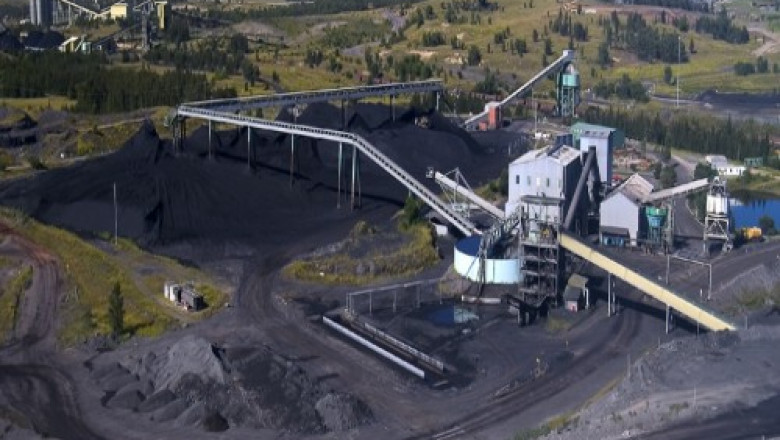views
What is Clean Coal Technology?
Clean coal technology refers to a set of technologies that aim to mitigate the environmental impact of burning coal. Coal is a fossil fuel that provides around 38% of the world's electricity but also releases harmful pollutants like carbon dioxide, sulfur dioxide, nitrogen oxides and mercury when burned. Clean coal technology seeks to reduce or capture these pollutants at their source during combustion or remove them from flue gases before they are released into the air.
Types of Clean Coal Technologies
There are several different types of clean coal technologies currently being used or developed:
Carbon Capture and Storage (CCS)
Clean Coal Technology involves capturing the carbon dioxide emissions from coal-fired power plants and storing it securely underground or using it for enhanced oil recovery. Pre-combustion capture separates and captures CO2 before combustion while post-combustion capture removes CO2 from flue gases after combustion. CCS aims to significantly reduce CO2 emissions from coal to mitigate climate change.
Pulverized Coal Combustion with Flue Gas Desulfurization
This technology involves burning finely ground coal powder in a boiler to generate steam. Flue gas desulfurization systems, commonly known as scrubbers, are used to spray limestone slurry into the flue gases to remove sulfur dioxide through a chemical reaction. This results in a significant reduction of SO2 emissions.
Integrated Gasification Combined Cycle (IGCC)
IGCC converts coal into a clean-burning syngas or fuel gas in an oxygen-blown coal gasifier at high temperatures and pressures. The syngas is then burned in a combustion turbine to generate electricity and the waste heat from this process is then used to produce more electricity in a steam turbine. IGCC achieves lower emissions of sulfur dioxide, mercury, and particulate matter compared to pulverized coal plants.
Advanced Pulverized Coal Combustion
This technology applies advanced steam conditions and materials to achieve higher efficiencies from coal-fired boilers. Low NOx burners, over-fire air and advanced steam conditions help cut nitrogen oxide emissions. Fabric filter baghouses and electrostatic precipitators further reduce particulate matter emissions.
Coal Cleaning and Beneficiation
Coal cleaning refers to a number of techniques that reduce the ash and sulfur contents of coal by separating impurities before combustion. Physical cleaning methods use processes like froth flotation to separate coal from its ash components based on differences in specific gravity. Chemical cleaning dissolves and removes mineral matter from coal. Beneficiated coal results in lower pollution during combustion.
Major Demonstration Projects
Several pilot and demonstration projects have been carried out globally to test clean coal technologies at commercial scale. Some notable examples are:
- Mountaineer Commercial-Scale Carbon Capture and Storage Project (USA) - Demonstrated carbon capture from an existing coal plant and secure geological storage since 2015.
- Petra Nova Carbon Capture Project (USA) - World's largest post-combustion carbon capture system capturing 1.6 million tons of CO2 annually since 2017.
- Kemper County IGCC with CCS Project (USA) - First commercial-scale coal gasification plant with integrated CCS cancelled in 2017 due to massive cost overruns.
- W.A. Parish Post-Combustion Carbon Capture and Storage Project (USA) - Retrofitted an existing coal plant with post-combustion capture and sequesters 800,000 tons of CO2 annually since 2012.
- Lacq Carbon Dioxide Capture and Storage Pilot (France) - One of Europe's first integrated CCS demonstration projects capturing 85,000 tons of CO2 annually since 2011.
Barriers to Widespread Deployment
While clean coal technologies show promise, a number of challenges still need to be overcome for their widespread commercial deployment:
- High capital costs - CCS and advanced coal plant retrofits entail huge upfront expenses which make projects difficult to finance.
- Integration complexities - Retrofitting pollution controls to existing plants affects design and efficiency requiring optimization.
- Limited infrastructure - Lack of CO2 pipelines and storage sites create geographical bottlenecks for large-scale CCS.
- Uncertain regulations and policies - An inconsistent regulatory framework and lack of a price on carbon hamper investment decisions.
- Public resistance - Fears around long-term storage safety and clean coal's role in climate policy remain obstacles.
By increasing efficiency, reducing emissions and mitigating carbon, clean coal technologies offer a pathway to sustain coal's contribution to global energy supply in an environmentally responsible way. However, significant progress is still needed on driving down costs, building infrastructure and addressing policy barriers before they can be deployed at scale. With continued support for demonstration projects and a conducive policy push, clean coal may help ensure a balanced, diverse and sustainable long-term energy future.
About Author:
Money Singh is a seasoned content writer with over four years of experience in the market research sector. Her expertise spans various industries, including food and beverages, biotechnology, chemical and materials, defense and aerospace, consumer goods, etc. (https://www.linkedin.com/in/money-singh-590844163)






















Comments
0 comment